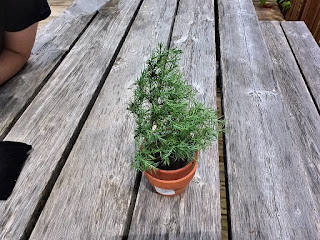Inspired by +Harry Harrington's beautiful work and guided by his website bonsai4me I have begun a new collection.
These are a few of the trees I collected earlier this spring. The maple and wild plum are still in the soil I found them in. You can see that the soil in the maple's pot is a heavy clay so I'll have to repot him soon. I am working on some home made akadama from that same clay so he may be the first to test it. The little wild plum looks like it survived the lawn mower at some point.
The willow is a cutting from a tree in my yard. This is one of the six that rooted. I was a bit surprised how easy it is to propagate willow. Only one of the seven cuttings died. The willows that I have observed around here make me think that this species should be a good beginners tree. They grow in the middle of the swamp and seem survive fairly devastating storm damage. The oldest trees are very gnarly and full of holes. I have high hopes for these little sprouts.
I literally tore the two juniper out of the ground. Rescued them from a landscaped area where they were not welcome. I began digging but soon found that the majority of the roots were underneath the weed barrier. I just pulled them out when it became clear that I would not get enough of a rootball to keep them alive. The smaller of the two only had one feeder root and about an inch of tap root, but I could not bring myself to compost them. I put them in dirt and placed each in a zipper closure plastic bag which I inflated with breath. I hoped the co2 and moisture in my breath would help them out somehow. Surprisingly, they both have survived a couple of months now. The new growth has hardened off, though a bit distorted from being a bit confined. I think they should stay in their private greenhouses a bit longer to be safe. I wish I had planted them in a transparent container to keep track of root development. I would like to do some experiments with seedlings to see if the same Ziploc method would speed growth at all. There's a project for another day.
These are a few of the trees I collected earlier this spring. The maple and wild plum are still in the soil I found them in. You can see that the soil in the maple's pot is a heavy clay so I'll have to repot him soon. I am working on some home made akadama from that same clay so he may be the first to test it. The little wild plum looks like it survived the lawn mower at some point.
The willow is a cutting from a tree in my yard. This is one of the six that rooted. I was a bit surprised how easy it is to propagate willow. Only one of the seven cuttings died. The willows that I have observed around here make me think that this species should be a good beginners tree. They grow in the middle of the swamp and seem survive fairly devastating storm damage. The oldest trees are very gnarly and full of holes. I have high hopes for these little sprouts.
I literally tore the two juniper out of the ground. Rescued them from a landscaped area where they were not welcome. I began digging but soon found that the majority of the roots were underneath the weed barrier. I just pulled them out when it became clear that I would not get enough of a rootball to keep them alive. The smaller of the two only had one feeder root and about an inch of tap root, but I could not bring myself to compost them. I put them in dirt and placed each in a zipper closure plastic bag which I inflated with breath. I hoped the co2 and moisture in my breath would help them out somehow. Surprisingly, they both have survived a couple of months now. The new growth has hardened off, though a bit distorted from being a bit confined. I think they should stay in their private greenhouses a bit longer to be safe. I wish I had planted them in a transparent container to keep track of root development. I would like to do some experiments with seedlings to see if the same Ziploc method would speed growth at all. There's a project for another day.








